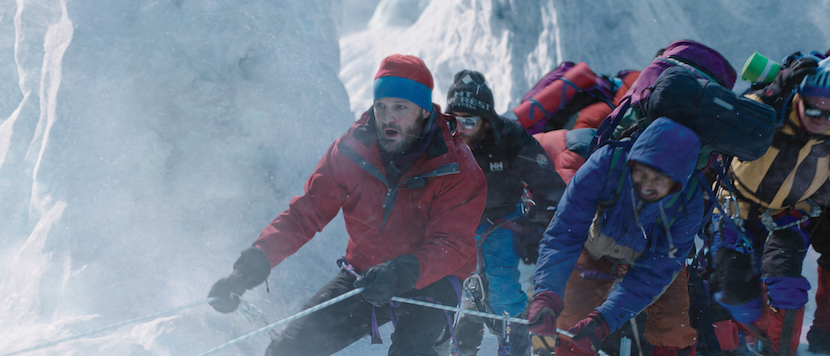Making Mountains With Everest VFX Supervisor Dadi Einarsson
Everest tells the true story of two groups of climbers who were hit with a deadly blizzard during their 1996 expeditions to scale the world’s highest mountain. We talk to visual effects supervisor Dadi Einarsson about the responsibility of recreating real events and why, being from Iceland, he may just have the edge when it comes to working with snow.
As Everest is shown in 3-D and on IMAX screens, what sort of extra considerations does that bring for you from a visual effects perspective?
Technically it wasn't that different. There were some extra considerations going towards the back end, just with helping with post-compression. Basically supplying assets and elements for the process. But probably the biggest consideration is just that it's a bigger canvas in the end and the work needs to hold up to even more scrutiny.
You can't get away with as much?
Yeah, there's no place to hide on that big screen.

Rob Hall (Jason Clarke) leads an expedition to summit Everest. Courtesy Universal Pictures
You've worked on things like Sherlock Holmes, Boardwalk Empire and Gravity was a big one, obviously. Do you take a different approach when you know that it's based on a true story? How does that affect your work?
There’s always a big responsibility to the director [Baltasar Kormákur] and producers to produce good work. When it's a true story and particularly when it’s a tragedy like this where people died, there's also a responsibility to the families of those who died and to the survivors. In the same way that the director and producers have the responsibility in how they tell the story we have to ensure that visually, what we do, doesn't cheapen the experience in any way. In this case it's something that's grounded in reality: it absolutely needed to look real. If that illusion ever broke then you've probably done a very big disservice to everyone, and not least the people who had to live through it, or were affected by it.
What are the challenges of with working with snow?
In terms of visual effects, there're a lot of computationally digital things that we need to do. To simulate where you have flurries of snow, and these kinds of things, it’s still quite computationally time consuming. When you work on a slow process like that it sometimes effects how many iterations and how creatively good you can make it look. When you have big areas of the screen filled with snow, then it's just a nuance thing. It's difficult to get the surface looking right. Any tiny deviations in the color will just explode when the film's graded at the end- tiny color shifts will really just be glaringly obvious.
Making sure the snow remained perfect takes a huge amount of computing power. Courtesy Universal Pictures.
I imagine that it's quite a tricky canvas when you're dealing with a lot of white all the time?
Right. It's not just white. There're hues and shades in there. The light scatters inside it, so you get this luminous volume effect when you have glass crystals on the surface. There're flurries of snow flowing across it, hugging the surfaces. There's a ton of observation work that needs to be done. [Being based in Iceland] we recognize that we have plenty of opportunity for observation of snow.
Yes, of course! Did that come into it at all when you actually were chosen for the job?
Maybe, on some level: the fact that we are familiar with it. People probably think that we'll have a better understanding. It wasn't a deciding factor, but we can speak with confidence about the visual behavior of snow.
There have been a lot of great documentaries about summiting Everest. Considering that, did you feel quite a responsibility to get the look and feel right?
Absolutely. It's not a fantasy; it's not a made up environment. Also, it's the most famous mountain in the world. Those who really have an interest in climbing probably are at least familiar with how Everest looks and then there are the people who have actually summited Everest. If what we have done had been in any way inaccurate you’d get people complaining and saying, ‘That’s not what it looks like. This is bullshit’.
Was there a particular scene that was the trickiest from the visual effects perspective?
There’s a scene where they’re crossing a crevasse that was very tricky: that was an interior studio green screen set. So we had to create an environment with lots of nuance, snow, ice surfaces, ice flows, and a mini avalanche. But, to be honest, there were a lot of the same problems to solve throughout. There's no one big scene that was crazy or more different that the others. Each time we used the same methodology to get there. We needed a lot of observation and reviews and versions to make it look real and right.
Some of it was filmed on location in Nepal and also in the Italian Alps. How much of your job is the challenge of trying to bring that all together seamlessly with what you're doing on the green screens?
That's basically the sum of my job to make it blend seamlessly together.
Of all the movies that you've worked on, do you have a favorite?
I think Everest is close to the top.
Why is that?
It was just an epic journey throughout, the start to the end. We were flying in the helicopter around Everest, up and down the mountain, which was just a crazy opportunity. There were a lot of very, very big problems to solve and a lot of responsibility. It seems to have worked out in the end. We've had a lot of positive feedback from across the board: viewers, the director, producers and climbers. It's been a very big and, in the end, satisfying experience.



